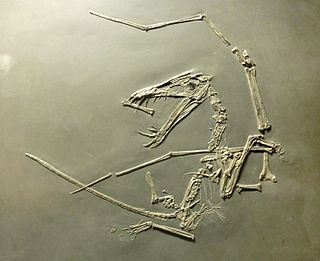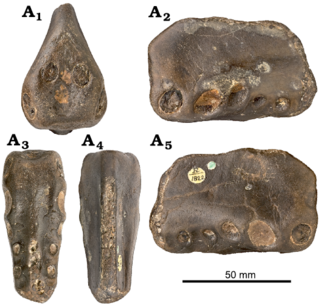
Kentrosaurus is a genus of stegosaurid dinosaur from the Late Jurassic in Lindi Region of Tanzania. The type species is K. aethiopicus, named and described by German palaeontologist Edwin Hennig in 1915. Often thought to be a "primitive" member of the Stegosauria, several recent cladistic analyses find it as more derived than many other stegosaurs, and a close relative of Stegosaurus from the North American Morrison Formation within the Stegosauridae.

Eudimorphodon was a pterosaur that was discovered in 1973 by Mario Pandolfi in the town of Cene, Italy and described the same year by Rocco Zambelli. The nearly complete skeleton was retrieved from shale deposited during the Late Triassic, making Eudimorphodon one of the oldest pterosaurs known. It had a wingspan of about 100 centimeters (3.3 ft) and at the end of its long bony tail may have been a diamond-shaped flap like in the later Rhamphorhynchus. If so, the flap may have helped it steer while maneuvering in the air. Eudimorphodon is known from several skeletons, including juvenile specimens.

Dimorphodon was a genus of medium-sized pterosaur from the early Jurassic Period. It was named by paleontologist Richard Owen in 1859. Dimorphodon means "two-form tooth", derived from the Greek δι meaning "two", μορφη meaning "shape" and οδων meaning "tooth", referring to the fact that it had two distinct types of teeth in its jaws – which is comparatively rare among reptiles. Dimorphodon inhabited Europe.

Giraffatitan is a genus of sauropod dinosaur that lived during the late Jurassic Period in what is now Lindi Region, Tanzania. It was originally named as an African species of Brachiosaurus (B. brancai), but this has since been moved to its own genus. Giraffatitan was for many decades known as the largest dinosaur but recent discoveries of several larger dinosaurs prove otherwise; giant titanosaurians appear to have surpassed Giraffatitan in terms of sheer mass. Also, the sauropod dinosaur Sauroposeidon is estimated to be taller and possibly heavier than Giraffatitan.

Batrachognathus is an extinct genus of anurognathid pterosaur from the Late Jurassic Karabastau Formation of the central Asian republic of Kazakhstan. The genus was named in 1948 by the Russian paleontologist Anatoly Nicolaevich Ryabinin. The type species is Batrachognathus volans. The genus name is derived from Greek batrakhos, "frog" and gnathos, "jaw", in reference to the short wide head. The specific epithet means "flying" in Latin.

Sordes was a small pterosaur from the late Jurassic (Oxfordian/Kimmeridgian) Karabastau Svita of Kazakhstan.

Dorygnathus was a genus of pterosaur that lived in Europe during the Early Jurassic period, 180 million years ago when shallow seas flooded much of the continent. It had a short 1.5 meters wingspan, and a relatively small triangular sternum, which is where its flight muscles attached. Its skull was long and its eye sockets were the largest opening therein. Large curved fangs that "intermeshed" when the jaws closed featured prominently at the front of the snout while smaller, straighter teeth lined the back. Having variable teeth, a condition called heterodonty, is rare in modern reptiles but more common in basal ("primitive") pterosaurs. The heterodont dentition in Dorygnathus is consistent with a piscivorous (fish-eating) diet. The fifth digit on the hindlimbs of Dorygnathus was unusually long and oriented to the side. Its function is not certain, but the toe may have supported a membrane like those supported by its wing-fingers and pteroids. Dorygnathus was according to David Unwin related to the Late Jurassic pterosaur, Rhamphorhynchus and was a contemporary of Campylognathoides in Holzmaden and Ohmden.

Germanodactylus is a genus of germanodactylid pterodactyloid pterosaur from Upper Jurassic-age rocks of Germany, including the Solnhofen Limestone. Its specimens were long thought to pertain to Pterodactylus. The head crest of Germanodactylus is a distinctive feature.

Campylognathoides is an extinct genus of pterosaur discovered in the Württemberg Lias deposits of Germany; this first specimen however, consisted only of wing fragments. Further better preserved specimens were found in the Holzmaden shale; based on these specimens, Felix Plieninger erected a new genus.

Coloborhynchus is a genus of pterodactyloid pterosaur belonging to the family Anhangueridae, though it has also been recovered as a member of the Ornithocheiridae in some studies. Coloborhynchus is known from the Lower Cretaceous of England, and depending on which species are included, possibly the Albian and Cenomanian ages as well. Coloborhynchus was once thought to be the largest known toothed pterosaur, however, a specimen of the closely related Tropeognathus is now thought to have had a larger wingspan.

Cycnorhamphus is a genus of gallodactylid ctenochasmatoid pterosaur from the Late Jurassic period of France and Germany, about 152 million years ago. It is probably synonymous with the genus Gallodactylus.

Feilongus is an extinct genus of ctenochasmatid pterodactyloid pterosaur from the Barremian–Aptian-age Lower Cretaceous Yixian Formation of Beipiao, Liaoning, China.

Lonchodectes was a genus of lonchodectid pterosaur from several formations dating to the Turonian of England, mostly in the area around Kent. The species belonging to it had been assigned to Ornithocheirus until David Unwin's work of the 1990s and 2000s. Several potential species are known; most are based on scrappy remains, and have gone through several other generic assignments. The genus is part of the complex taxonomy issues surrounding Early Cretaceous pterosaurs from Brazil and England, such as Amblydectes, Anhanguera, Coloborhynchus, and Ornithocheirus.

The Tendaguru Formation, or Tendaguru Beds are a highly fossiliferous formation and Lagerstätte located in the Lindi Region of southeastern Tanzania. The formation represents the oldest sedimentary unit of the Mandawa Basin, overlying Neoproterozoic basement, separating by a long hiatus and unconformity. The formation reaches a total sedimentary thickness of more than 110 metres (360 ft). The formation ranges in age from the late Middle Jurassic to the Early Cretaceous, Oxfordian to Hauterivian stages, with the base of the formation possibly extending into the Callovian.

Ornithocheiroidea is a group of pterosaurs within the extinct suborder Pterodactyloidea. They were typically large pterosaurs that lived from the Early to Late Cretaceous periods, with fossil remains found all over the world except Antarctica.

Azhdarchoidea is a group of pterosaurs within the suborder Pterodactyloidea, more specifically within the group Ornithocheiroidea. Pterosaurs belonging to this group lived throughout the Early and Late Cretaceous periods, with one tentative member, Tendaguripterus, that lived in the Late Jurassic period. The largest azhdarchoids include members of the family Azhdarchidae, examples of these are Quetzalcoatlus, Hatzegopteryx, and Arambourgiania. The Azhdarchoidea has been recovered as either closely related to the Ctenochasmatoidea, as the sister taxon of the Pteranodontoidea within the Ornithocheiroidea, or within the Tapejaroidea, which in turn was also within the Ornithocheiroidea.

Dsungaripteridae is a group of pterosaurs within the suborder Pterodactyloidea. They were robust pterosaurs with good terrestrial abilities and flight honed for inland settings.

Ostafrikasaurus is a genus of theropod dinosaur from the Late Jurassic period of what is now Lindi Region, Tanzania. It is known only from fossil teeth discovered sometime between 1909 and 1912, during an expedition to the Tendaguru Formation by the Natural History Museum of Berlin. Eight teeth were originally attributed to the dubious dinosaur genus Labrosaurus, and later to Ceratosaurus, both known from the North American Morrison Formation. Subsequent studies attributed two of these teeth to a spinosaurid dinosaur, and in 2012, Ostafrikasaurus crassiserratus was named by French palaeontologist Eric Buffetaut, with one tooth as the holotype, and the other referred to the same species. The generic name comes from the German word for German East Africa, the former name of the colony in which the fossils were found, while the specific name comes from the Latin words for "thick" and "serrated", in reference to the form of the animal's teeth.

Ikrandraco is a genus of lonchodraconid pterodactyloid pterosaur known from Lower Cretaceous rocks in northeastern China and the Cambridge Greensand of the UK. It is notable for its unusual skull, which features a crest on the lower jaw.

Tapejaroidea is a group of pterosaurs belonging to the clade Ornithocheiroidea. Tapejaroids lived from the Early to Late Cretaceous periods, with one possible member, Tendaguripterus, extending the fossil range to the Late Jurassic period. Tapejaroidea contains two groups, the Dsungaripteridae and the Azhdarchoidea, which in turn includes the azhdarchids, the group that contains some of the largest flying animals. The group was named by Brazilian paleontologist Alexander Wilhelm Armin Kellner in 1996.
































